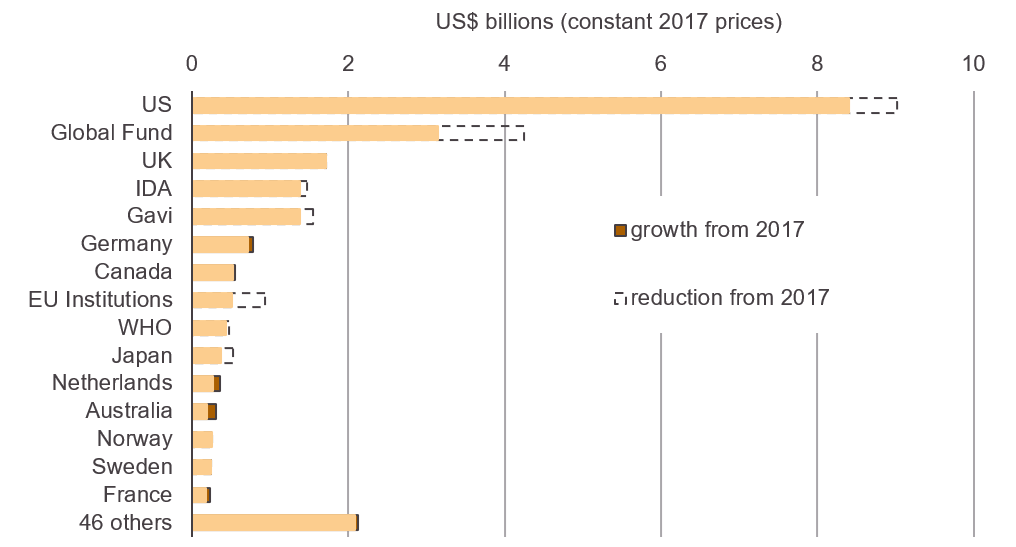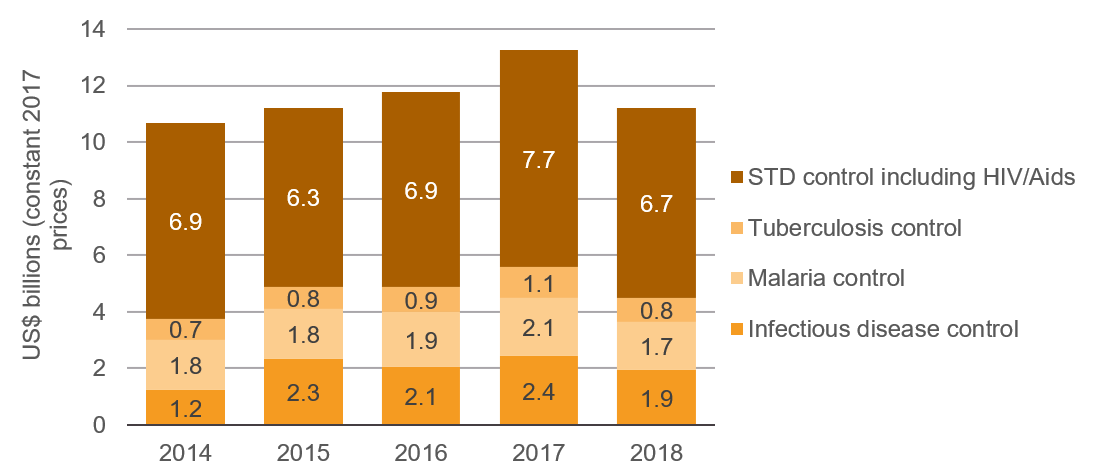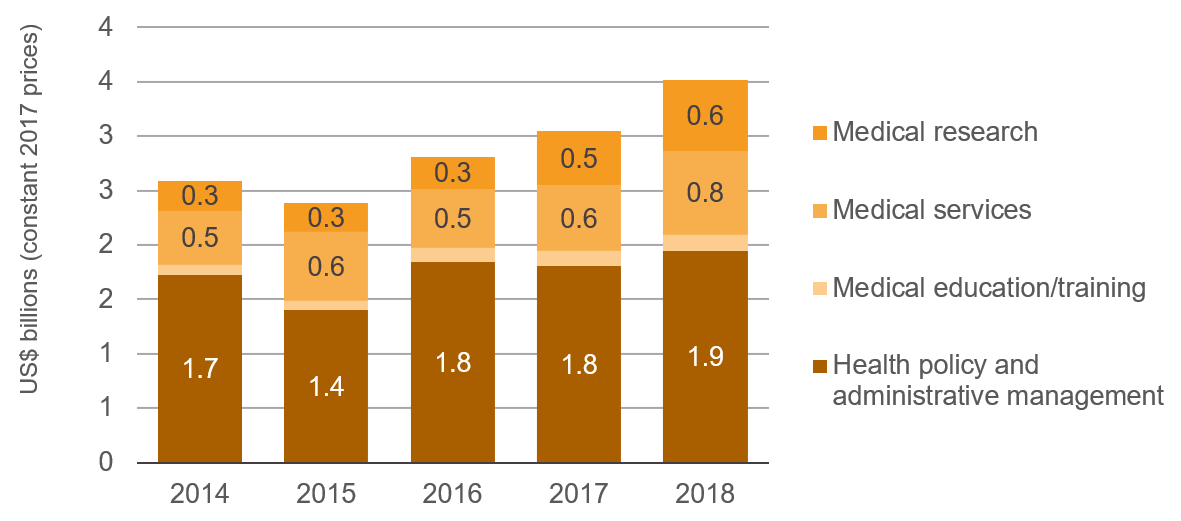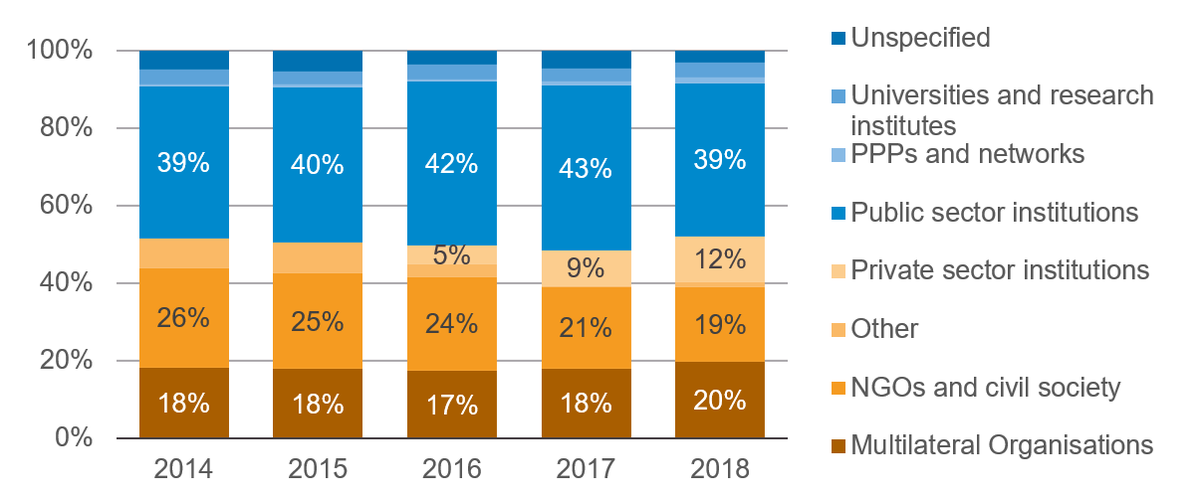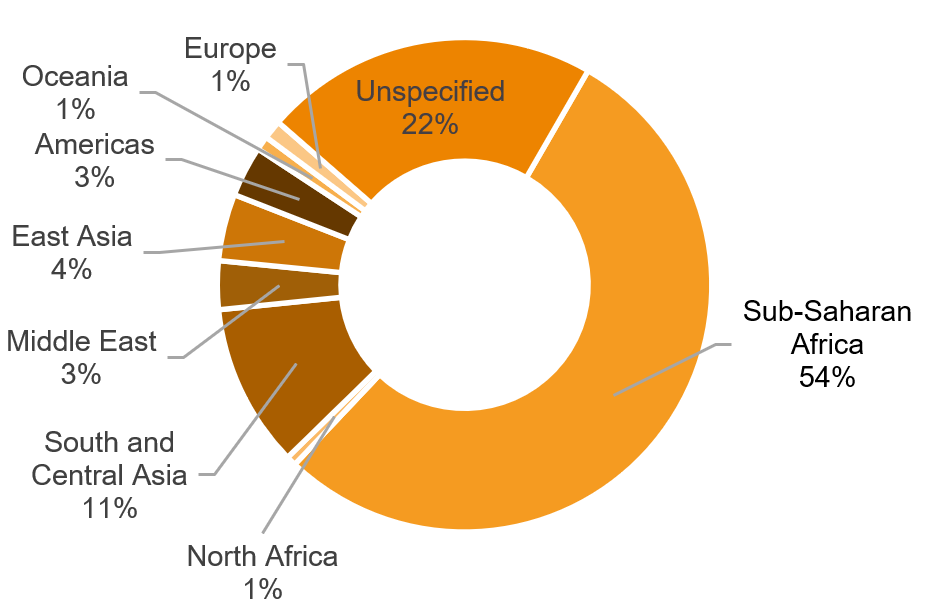Aid spent on health: ODA data on donors, sectors, recipients
The latest data on trends in ODA to health. Who are the major donors, and where is health ODA expenditure disbursed, at recipient and subsector level?
DownloadsAn overview of aid spending on health
Ensuring people are healthy is recognised as an essential role of sustainable development. Access to healthcare at the individual level, as well as wider health investments in areas such as the prevention of diseases and health system strengthening, are key social sector interventions for improving quality of life and wellbeing. Good health can contribute to economic development, for example by increasing labour productivity and educational attainment. [1] Furthermore, in the context of the coronavirus crisis, investments in the health sector are critical to:
- contain and respond to the pandemic
- mitigate the impact on other health issues, due to health systems being overwhelmed, reallocation of resources towards coronavirus or more restricted global and national access under quarantine measures.
Global growth in domestic and international health sector spending has been at 3.9% annually since 2000, outpacing wider economic growth over the same period (3.0% annually); however, the volume and source of finance available for health can vary substantially between different countries. [2] Presently more than half of health expenditure within high-income and upper-middle-income countries is from domestic public sources, whereas the same source of expenditure accounts for less than a quarter of health expenditure in least developed countries (LDCs). This group of countries experience severe structural impediments to sustainable development and are highly vulnerable to economic and environmental shocks. Domestic government expenditure on health in LDCs was PPP [3] $29 per capita in 2017 – more than 100 times lower than in high-income countries (PPP$3,692 in 2017). Available domestic resources for health often do not reach internationally recognised spending targets. The 2001 Abuja Declaration’s [4] target of health expenditure making up 15% of total government expenditure has been met by only 4 out of 82 countries with LDC, low-income or lower-middle-income status. [5] [6]
Official development assistance (ODA) is an international resource provided largely by the Development Assistance Committee (DAC) donors and multilateral bodies. It is aimed explicitly at the economic development and welfare of developing countries, and therefore well positioned to target places where need is greatest. Given the shortfall of domestic public resources required to fully meet healthcare needs, ODA towards health can be a significant resource within certain country contexts. While ODA accounts for 1.5% of health expenditure within all developing countries, it makes up a fifth of health expenditure within LDCs. [7] [8]
This paper examines key trends in ODA to health, using the latest data [9] to assess who the major donors are and where health ODA expenditure is disbursed, at the recipient and subsector level. Knowing where need is greatest and what form of investment is required (from emergency support to longer-term health systems strengthening) is key to ensuring that support is well targeted. To learn more about how health ODA is targeted, you can read our factsheet ‘Targeting health ODA to need: Spending by country and disease’ .
Key facts about aid spending on health
Aid accounted for 1.5% of health finance in developing countries
Estimated financial resources to health in ODA-eligible countries stood at US$1.5 trillion in the latest year for which data is available. [10] [11] ODA accounted for 1.5% of the total financial resources for health available within developing countries, and domestic forms of health expenditure accounted for 98% of health financing (see Figure 1).
Aid to health has grown over the last decade, peaking in 2017
ODA to the health sector between 2009 and 2018 has generally increased (see Figure 2). Levels peaked in 2017 at US$24.4 billion, before falling by 9% to US$22.2 billion in 2018. However, while total volumes of health ODA have increased since 2009, health sector ODA as percentage of total ODA remained unchanged over the last decade: levels were 13.1% in 2009 and 13.0% in 2018.
The top three donors accounted for 60% of aid to health in 2018, and the top 15 accounted for 90%
A significant proportion of ODA to this sector is concentrated among a small number of actors (see Figure 3). The top three donors are the US, the Global Fund and the UK; together they provided 60% of health ODA in 2018. The top 15 donors provided 90%.
Health aid supports a variety of subsectors; over half of health ODA is focused towards combatting diseases, however funding to this decreased between 2017 and 2018
Health ODA is focused towards a number of subsectors, including the control of specific diseases, basic health, reproductive health and general health (see Figure 4). Reported levels of ODA towards sexually transmitted disease (STD) control – including HIV/Aids, [12] malaria, tuberculosis and other infectious diseases – decreased by 15% between 2017 and 2018, reducing from US$13.3 billion to US$11.2 billion (see Figure 5).
- Over half of disease control funding is spent on HIV/Aids
- Aid to basic health has decreased by 14% since peaking in 2017
- Aid to general health has increased year on year since 2015
- Public institutions are the dominant channel for health sector ODA
Over half of health aid went to sub-Saharan Africa in 2018
Over half (53.7%) of health ODA in 2018 was disbursed to sub-Saharan Africa, totalling US$11.9 billion (Figure 9). The largest recipient country of health ODA in 2018 was Nigeria (US$951 million). Ethiopia and Tanzania were the second- and third-largest 2018 recipients (nine of the top ten recipients were in Africa).
Aid to health has fallen in a number of the largest recipients since 2017
Overall, out of the top 25 recipients of health ODA in 2018, 6 recorded increases in ODA since 2017 and 19 experienced decreases (Figure 10).
Trends in aid to health
Aid accounted for 1.5% of health finance in developing countries
- In 2018, health ODA stood at US$22.2 billion, 1.5% of the total financial resources for health available within developing countries.
- Domestic forms of health expenditure – including domestic general government health expenditure, domestic out-of-pocket health expenditure and other domestic private health expenditure [13] – accounted for 98% of health financing.
Figure 1: Domestic and international resource flows to health, 2017/2018

Aid accounted for 1.5% of health finance in developing countries
Source: Development Initiatives based on Organisation for Economic Cooperation and Development (OECD) Creditor Reporting System (CRS), OECD Development Assistance Committee (DAC), UN Office for the Coordination of Humanitarian Affairs (OCHA) Financial Tracking Service (FTS) and World Health Organization Global Health Expenditure Database.
Notes: Data shown is for the latest year available for each flow: 2018 for ODA, private development assistance, humanitarian aid and other official flows; 2017 for blended finance and domestic public and private healthcare. Blended finance refers to blended finance mobilised by the private sector. OOFs = other official flows.
Domestic general government health expenditure made up just over half (51%) of the total: US$757 billion in 2017. Domestic out-of-pocket health expenditure made up 36% of this total (US$534 billion), and other domestic private health expenditure made up 11%.
International resource flows to the health sector in developing countries made up 2% of the total. Outside of ODA, other international flows to the sector included international private development assistance, humanitarian aid, other official flows and blended finance mobilised by the private sector. [14] International private development assistance stood at US$3.1 billion in 2018 (0.2% of the total) – expenditure reported from this flow has increased by 82% since 2009. [15] Other official flows to the health sector stood at US$1.3 billion in 2018 (0.1% of total domestic and international health finance) – these flows increased by 36% between 2009 and 2018. [16] Blended finance mobilised from the private sector stood at US$1.8 billion in 2017 (0.1% of total health finance) – levels of this flow to the health sector have increased by a factor of almost 20 since 2012. [17] Despite the significant increases recorded in other international resource flows, ODA remains the prominent international resource flow to health.
Aid to health grew over the last decade, peaking in 2017
- ODA to the health sector generally increased between 2009 and 2018 (see Figure 2). Levels peaked in 2017 at US$24.4 billion, before falling by 9% to US$22.2 billion in 2018.
- While total volumes of health ODA have increased since 2009, health sector ODA as a percentage of total ODA functionally stagnated over the last decade: levels were 13.1% in 2009 and 13.0% in 2018.
Figure 2: Volume and share of ODA to health by donor type, 2009–2018
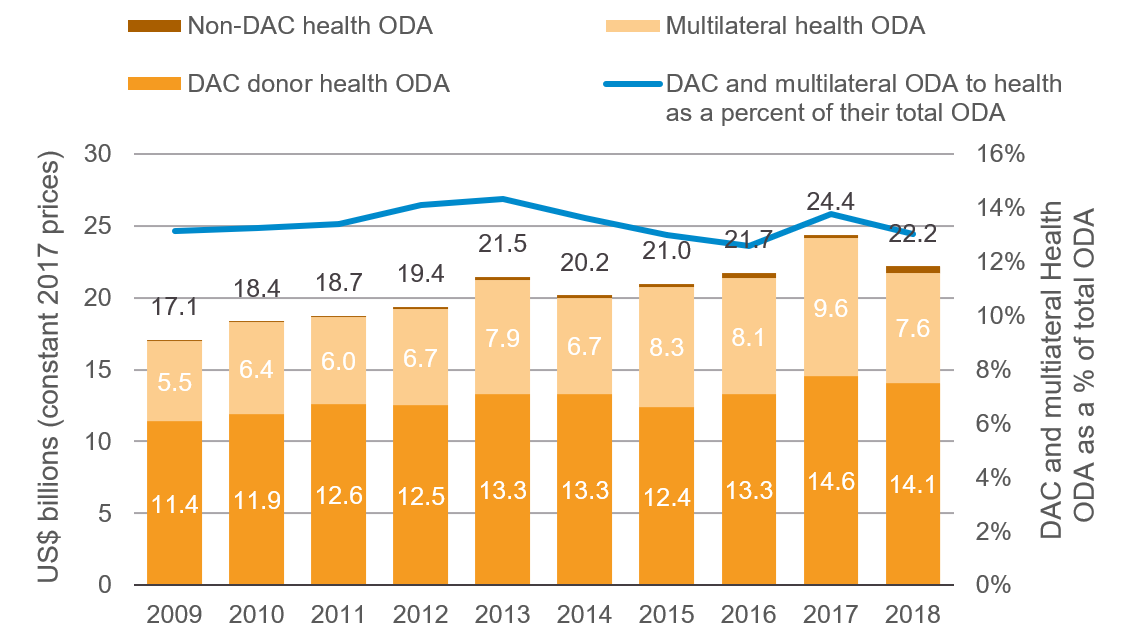
Volume and share of ODA to health by donor type, 2009–2018
Source: Development Initiatives, based on Organisation for Economic Cooperation and Development (OECD) Creditor Reporting System (CRS).
Notes: Data is gross disbursements. ODA is from DAC, multilateral and non-DAC donors reporting to the OECD CRS.
DAC members and multilateral organisations are prominent donors of aid to health. Of all health-related ODA in 2018, just under two-thirds (63.6%) was disbursed by DAC donors. This represented 12.3% of total ODA disbursements made by DAC donors in 2018.
Since 2009, the level of health ODA disbursed by DAC donors as a percentage of total disbursements has marginally decreased (from 12.5% to 12.3%); however, this share has fallen to a greater extent in more recent years. In volume terms, health ODA from DAC donors peaked in 2017.
Multilateral organisations accounted for over a third (34.5%) of health-related ODA in 2018. Since 2009, multilateral health ODA as a percentage of total multilateral ODA marginally increased from 14.7% in 2009 to 14.8% in 2018, this share peaked in 2017 at 17.3%.
In 2018, 2.0% of health-related ODA was disbursed by non-DAC donors; this amounted to US$435.1 million. Volumes of non-DAC ODA to health have quadrupled over the last decade; however, the share of non-DAC ODA allocated to health has declined. In 2012, 13.2% of non-DAC ODA was disbursed to the health sector, but by 2018 the proportion was just 2%.
The top three donors accounted for 60% of aid to health in 2018, and the top 15 accounted for 90%
- The top three donors are the US, the Global Fund and the UK: these provided 60% of health ODA in 2018.
- ODA to this sector is concentrated among a number of actors: the top 15 donors accounted for 90% of disbursements (see Figure 3).
- The US and the Global Fund, the two largest donors of ODA to health between 2017 and 2018, both saw reductions in health ODA over this period.
- ODA to health is expected to be available to aid the response to the Covid-19 pandemic, and to mitigate the impact on programmes designed to combat other health issues.
The US was the largest donor of ODA to health in 2018, disbursing US$8.4 billion, and accounting for 37.9% of total health disbursements. Levels from the US decreased 6.8% from 2017, when the US disbursed US$9.0 billion.
The Global Fund was the next-largest donor of health ODA in 2018. It also saw a significant reduction in the disbursements in health ODA between 2017 and 2018. In 2017 the Global Fund disbursed US$4.3 billion and in 2018 they disbursed US$3.1 billion, a decrease of 25.9%. In 2018 the Global Fund accounted for 41.2% of all multilateral disbursements to the health sector.
The third-largest donor in 2018 was the UK, with disbursements of US$1.7 billion 2018. Over a quarter (27.8%) of UK disbursements of health ODA were towards medical research. The next-largest subsector was towards family planning, which accounted for 12.9% of UK health ODA in 2018.
There are three further multilateral organisations within the top 15 donors of health aid in 2018: IDA (the part of the World Bank that helps the world’s poorest countries by providing grants and concessional loans), the WHO, and Gavi, the Vaccine Alliance. They all reported reduced disbursements to the health sector between 2017 and 2018. This was particularly linked to decreases in disbursements to infectious disease control ODA. In 2017, these multilaterals disbursed a total of US$465 million to infectious disease control; in 2018 disbursements decreased by a third (32.9%) to US$312 million.
Despite some significant decreases, several donors reported an increase in health ODA disbursements between 2017 and 2018. Germany increased its disbursements to health ODA by 9.0%, up from US$711.4 million in 2017 to US$775.4 million in 2018. Canada, the Netherlands, Australia and France were the other donors among the top 15 in 2018 who increased their disbursements between 2017 and 2018.
ODA to health is expected to increase in response to Covid-19 – both to support action in response to the disease and to mitigate the impact on programmes designed to combat other health issues. [18] [19] For example, The Global Fund (a vertical fund, set up to combat Aids and malaria specifically) is providing immediate funding of up to US$1 billion (which represents close to a third of the Fund’s 2018 disbursements) to help countries fight Covid-19, to mitigate the impacts of this on other diseases it focuses on and to prevent fragile health systems from being overwhelmed. [20]
Over half of health ODA is focused towards combatting diseases
- Health ODA is focused towards a number of subsectors, including the control of specific diseases, basic health, reproductive health and general health.
- STD control was the largest focus subsector for health ODA over the last decade, with the vast majority of funding directed towards HIV/Aids.
- The control of other diseases (including malaria, tuberculosis and other infectious diseases) was the second-largest subsector grouping of health ODA over the last decade.
STD control including HIV/Aids was the largest focus subsector for health ODA over the last decade, with the vast majority of funding directed towards HIV/Aids. The percentage of total health ODA accounted for by this subsector fell between 2009 and 2018, from 41.3% to 30.4%. In volume terms, this subsector stood at US$6.7 billion in 2018, and had decreased by 12.4% from 2017.
Health ODA to population policy, family planning and reproductive health stood at US$3.1 billion in 2018 – representing a decade high. The majority of this total was made up of reproductive health (at US$1.6 billion) and family planning (at US$1 billion). Family planning ODA increased by a quarter between 2017 and 2018.
Health ODA to disease control (non-STD) stood at US$4.5 billion in 2018. While funding has increased to this grouping over the last decade, a 19% fall occurred between 2017 and 2018. Aid related to disease control is clearly connected with aid linked to pandemic responses: for example, donors reported significant levels (over 85%) of health sector funding related to the Ebola response within the ‘infectious disease control’ subsector.
ODA to basic health rose by 10% between 2014 and 2017, when totals peaked at US$5.1 billion. In 2018, the volume fell by US$693 million [21] to a total of US$4.4 billion, accounting for 20% of health ODA. For trends in aid to subsectors within the basic health area, see Figure 6 below.
ODA to general health stood at US$3.5 billion in 2018, with disbursements growing year on year between 2015 and 2018, increasing by 47% over this period. For trends in aid to subsectors within the general health area see Figure 7 below.
Aid to non-communicable diseases [22] stood at US$15 million in 2018 (levels to this subsector are not visible on Figure 4 due to scale). [23]
Over half of disease control funding is spent on HIV/Aids
Infectious diseases are a significant cause of mortality. For example, lower respiratory infections, malaria, tuberculosis and HIV/Aids and other sexually transmitted infections combined caused 25.9 million deaths in developing countries between 2013 and 2017. [24] ODA designed to combat diseases (which can include education, prevention, vaccines, diagnosis and treatment) is a crucial investment towards reducing the burden of diseases which remain underfunded. [25] [26] [27]
Reported levels of ODA to subsectors focused on the control of diseases fell by 15% between 2017 and 2018, from US$13.3 billion to US$11.2 billion. Between 2014 and 2018, ODA focused on disease control increased by 5% (however this rate is significantly lower than the 14% increase in total ODA reported over the same period by DAC and multilateral donors).
Since 2014, STD control (including HIV/Aids) has accounted for over half of expenditure allocated for the control of specific diseases. ODA to malaria control peaked in 2017 at US$2.1 billion, but levels decreased by 18% between 2017 and 2018 and were lower in 2018 as compared to 2014. ODA to tuberculosis control peaked in 2017 at US$1.1 billion, before declining by 20% in 2018.
Infectious disease control (which contains ODA focused on a number of diseases beyond those with their own subsectors, such as diarrhoeal diseases, vector-borne diseases, viral diseases or helminthiasis) accounted for 17.3% (US$1.9 billion) of the disease-focused total in 2018. Between 2014 and 2017, disbursements to infectious disease control doubled. This was linked to the Ebola crisis and increased funding for activities related to the treatment of Ebola. However, infectious disease control saw a 20.5% reduction in disbursements between 2017 and 2018. This was largely due to a 68.1% (US$470.2 million) reduction from the US to this area. In particular, the US Department of Health and Human Services saw a significant decrease in ODA disbursements to infectious disease control between 2017 and 2018.
Aid to basic health has decreased by 14% since peaking in 2017
Basic healthcare is comprised of primary healthcare programmes (including the supply of drugs, medicines and vaccines to support basic healthcare) and projects aimed at achieving universal health coverage. Basic healthcare was the largest subsector within the basic health grouping. Basic healthcare ODA disbursements peaked in 2017 at US$3.1 billion and fell by 10.0% to US$2.8 billion in 2018.
In 2018, health education accounted for 0.6% (US$134 million) of total health ODA. Health education includes activities relating to the education of individuals on proper handwashing as well as promotion of improved personal hygiene practices. ODA to this subsector peaked in 2017 before decreasing by 20% in 2018.
ODA to basic health infrastructure (which includes district-level hospitals, clinics and dispensaries and related medical equipment, and excludes specialised hospitals and clinics) stood at US$442 million in 2018, down by a third from 2017.
ODA to health personnel development, which includes the training of staff for basic healthcare services, stood at US$103 million in 2018 (0.5% of total health ODA). Disbursements to this area had peaked in 2015 at US$152 million, then decreased by 20% between 2017 and 2018.
Aid to general health has increased year on year since 2015
Expenditure on all subsectors of general health increased year on year between 2015 and 2018. General health ODA stood at US$3.5 billion in 2018, a 15.4% increase in disbursements on 2017.
Health policy and administrative management focuses on strengthening health systems through health-sector policy, planning and programmes; funding to health ministries and administration; and building capacity within the health sector. It accounted for the majority (61%) of the total general health expenditure over the five-year period. The increase in aid to health policy and administrative management is a positive development: stronger health systems are better able to respond to disease outbreaks; conversely, the absence of a functional health system can lead to worse outcomes related to a disease outbreak. [28]
Increased disbursements to medical research accounts for a significant proportion of the increase in general health ODA between 2014 and 2018. In 2014, medical research received 10.7% (US$276.3 million) of general health ODA, this rose to 18.4% (US$645.8 million) in 2018. A similar increase was seen in the medical services purpose code, which includes funding towards laboratories, ambulances and specialised clinics and hospitals. Funding increased by 57.1% from US$494.3 million in 2014 to US$776.5 million in 2018.
Public institutions are the dominant channel for health sector ODA
- Public sector institutions have been the largest health aid channel [29] each year since 2014. In 2018, 39% (US$8.8 billion) of health ODA was disbursed through the public sector.
- In 2018, a fifth of health sector ODA was channelled through multilaterals, while just under a fifth (19%) was channelled through NGOs and civil society.
- The proportion of health ODA disbursed through private sector institutions has grown in recent years, reaching a high of 11.7% of total health disbursements in 2018.
Of the health ODA disbursed through the public sector in the last five years, almost two-fifths (37.6%) originated from the US. The US reduced health ODA channelled through the public sector by 13.3% between 2017 and 2018.
The proportion of health ODA disbursed through multilateral organisations has increased from 18% to 20% since 2014. UN agencies represented the largest recipient of health aid channelled through multilaterals, receiving 84% of the total in 2018. Prominent UN channels included Unicef (44.7% of the 2018 UN total), the WHO (19%), UN Populations Fund (11.4%) and UN Development Programme (9.3%). Other large multilateral channels included the World Bank, which saw a significant increase from US$283 million in 2014 to US$449 million in 2018.
The vast majority of health ODA disbursed through private sector institutions is channelled through donor country private sectors. In 2018, 85.4% (US$2.2 billion) of all disbursements channelled through the private sector were channeled through those in the donor country.
The share of health ODA channelled through NGOs and civil society has fallen year on year between 2014 and 2018. In 2014, this channel represented 25.7% of health ODA; by 2018 it had fallen to 19.2%. NGOs based in donor countries saw the most significant change: US$1.1 billion, a fall of almost a third (32.7%) between 2014 and 2018. NGOs based in developing countries saw the most significant fall in percentage terms: falling 67%, from US$441 million in 2014 to US$147 million in 2018.
Over half of health aid went to sub-Saharan Africa in 2018
- Over half (54%) of health ODA in 2018 was disbursed to sub-Saharan Africa, totaling US$11.9 billion.
- 22% of health ODA was neither country allocable nor disbursed to a specified region. These regional unspecified projects include ODA which benefits several regions or non-country programmable aid such as in-donor country research.
Health ODA disbursed to sub-Saharan Africa accounted for more than half of all health ODA each year since 2012. In 2018, the top nine recipients of country-allocable health ODA were all in sub-Saharan Africa (see Figure 10).
Health ODA disbursed to Asia in 2018 totalled US$4 billion, accounting for 18.2% of the total. Over half of health ODA to Asia was disbursed to South and Central Asia (US$2.4 billion), while US$971 million went to East Asia and US$705 million went to the Middle East.
Just over a fifth (22%) of health ODA was neither country allocable nor disbursed to a specified region. This includes ODA that benefits several regions or non-country programmable aid, such as in-donor country research (including in-donor vaccine research). Other examples of unspecified health ODA include drug supply chain management (such as those protecting against HIV/Aids and polio) and vaccine, drug and diagnosis tool research and development.
Norway was the largest DAC donor in terms of proportion of health ODA disbursed to the unspecified category. It disbursed 73% (US$184 million) of its health ODA to unspecified regions in 2018 – much of this was in the form of contributions to specific-purpose programmes and funds managed by implementing partners. The next-largest DAC donors, in terms of proportion of health ODA disbursed to unspecified regions in 2018, were Denmark (59%) and the Netherlands (56%).
Aid to health has fallen in a number of the largest recipients since 2017
- The largest recipient country of health ODA in 2018 was Nigeria (US$951 million); however, levels to Nigeria were down 20.2% from 2017, when ODA stood at US$1.2 billion.
- Ethiopia and Tanzania were the second- and third-largest 2018 recipients, and nine of the top ten recipients were in Africa.
- Overall, out of the top 25 recipients of health ODA in 2018, 6 recorded increases in ODA since 2017 and 19 experienced decreases.
Figure 10: Top 25 recipients of health ODA (country allocable), 2017 to 2018
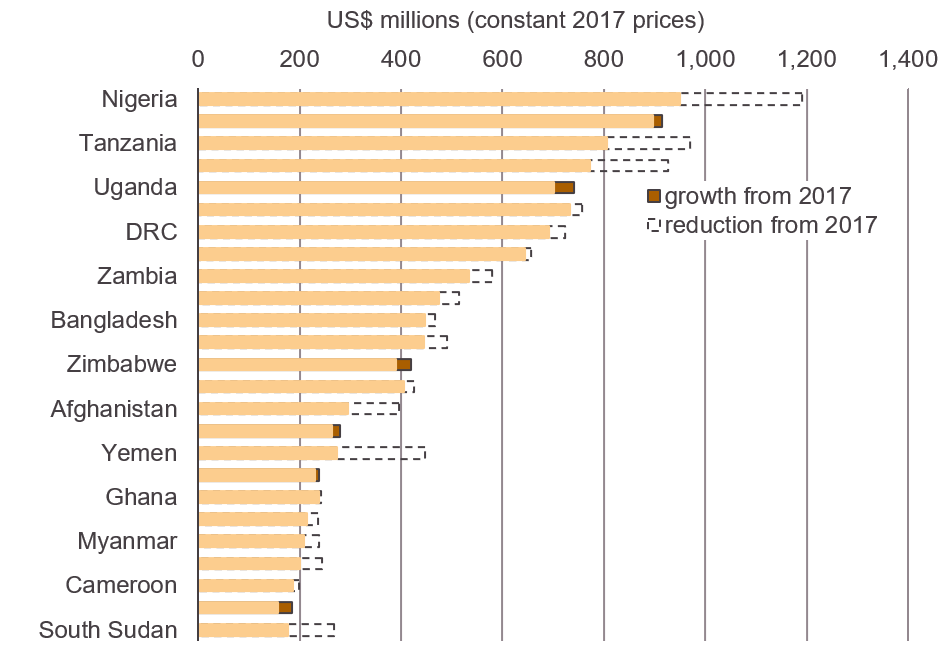
Top 25 recipients of health ODA (country allocable), 2017 to 2018
Source: Development Initiatives, based on Organisation for Economic Cooperation and Development (OECD) Creditor Reporting System (CRS). Note: IDA = International Development Association.
2017 represented a spike in ODA disbursements to Nigeria (aid from the Global Fund to Nigeria increased by 46% between 2016 and 2017, which contributed to the overall rise), while 2018 was a five-year low. This reduction was driven by decreases in aid to basic healthcare, infectious disease control, reproductive healthcare and STD control (including HIV/Aids) between 2017 and 2018.
Ethiopia was the second-largest country recipient of health ODA in 2018 (US$916 million). This was up slightly (by US$18.5 million) from the level of disbursements received in 2017, despite the fact that the top three donors of health ODA to Ethiopia in 2017 (the US, the Global Fund and the UK) all decreased their volumes in 2018 (the latter two by over a quarter). However, IDA more than tripled health ODA to Ethiopia between 2017 and 2018, making it the second-largest donor to Ethiopia that year. The US was the largest donor to Ethiopia and the Global Fund was the third largest.
The third-largest recipient in 2018 was Tanzania, receiving US$806 million, however, levels were down by US$165 million from 2017. The Global Fund recorded substantial decreases (of US$151 million, or 61%) to this recipient into 2018.
A few other recipients saw increases in the level of health ODA disbursements received in 2018. For example, disbursements to Uganda increased by US$39.4 million (5.6%) between 2017 and 2018, the largest increase in terms of volume across all recipients. Levels to Zimbabwe increased by 7.3% from US$391 million in 2017 to US$419 million in 2018. Overall, out of the top 25 recipients of health ODA in 2018, six received increases in ODA since 2017 and 19 experienced decreases.
Downloads
Notes
-
1
OECD/WHO, 2003. DAC Guidelines and Reference Series: Poverty and Health, OECD, Paris. Available at: www.who.int/tobacco/research/economics/publications/oecd_dac_pov_health.pdfReturn to source text
-
2
World Health Organization, 2019. Global Spending on Health: A World in Transition. Available at: https://www.who.int/health_financing/documents/health-expenditure-report-2019/en/Return to source text
-
3
Purchasing power parity (PPP) prices are the rate at which a country's currency would have to be converted into that of another country to buy the same amount of goods and services in each country. PPPs are constructed by comparing the cost of a common basket of goods in different countries. The PPP series used was generated by the 2011 International comparison project (ICP) estimated by the World Bank.Return to source text
-
4
African Union, 2001. ‘The Abuja Declaration on HIV/Aids, tuberculosis and other related infections diseases’. Available at: https://au.int/sites/default/files/pages/32904-file-2001_abuja_declaration.pdfReturn to source text
-
5
Subnational Investment in Human Capital. 2019. ODI and Development Initiatives. Available at: https://www.odi.org/sites/odi.org.uk/files/resource-documents/12663.pdfReturn to source text
Related content
Economic poverty trends: global, regional and national
Poverty is complex and it can be described and measured in a variety of ways. In this factsheet we unpack some of the key terminology alongside the latest trends in poverty at the global, regional and national levels.
Targeting health ODA to need: Spending by country and disease
Is health ODA spent where need is greatest? Our analysis considers aid in countries facing developmental challenges, and diseases that cause the most deaths.
Coronavirus and aid data: What the latest DAC data tells us
How might the coronavirus pandemic impact aid spending? DI presents analysis of preliminary ODA (aid) data for 2019. Our briefing shows how much was given and in what form.
